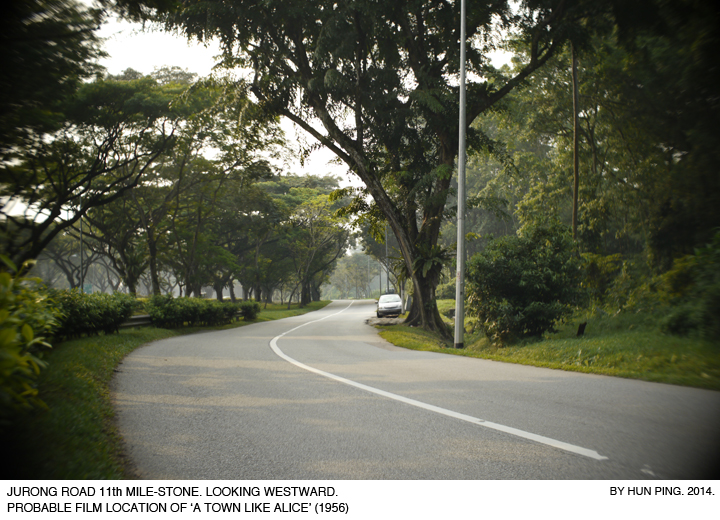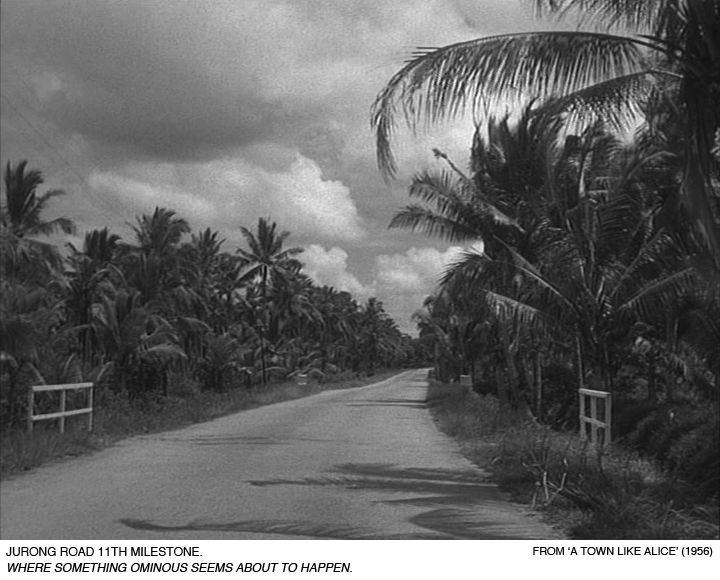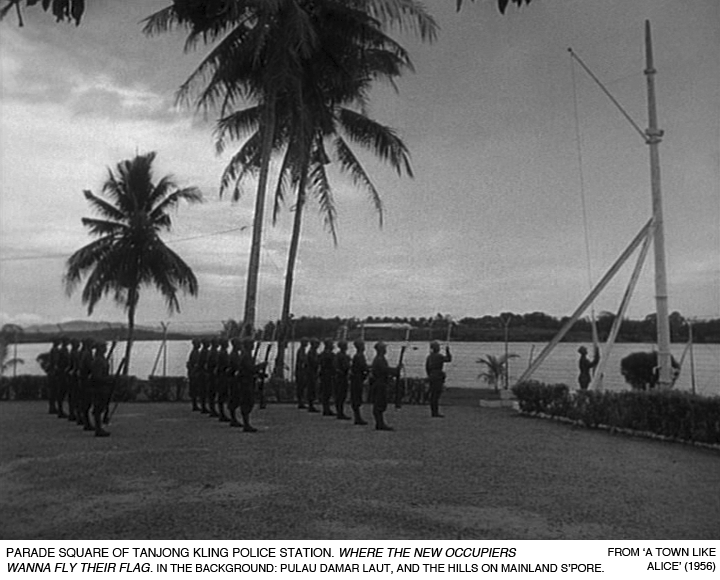Original film title: A Town Like Alice
Alternative film title: Rape of Malaya
Directed by Jack Lee
Written by Nevil Shute (novel), W. P. Lipscomb & Richard Mason (screenplay)
Language: English
Starring: Virginia McKenna, Peter Finch
Produced by Vic Film Production
Year of release: 1956
Film Locations:
Jurong Road 11th mile-stone
Tanjong Kling Police Station, Kampong Tanjong Kling
Tampines Road
“Estate near Seletar”
BASED ON NEVIL SHUTE’S BEST-SELLING NOVEL, A Town Like Alice portrays the tragic consequences encountered by a group of British women who did not manage to evacuate from colonial Malaya at the outbreak of the Japanese invasion during World War Two. The film centers on Jean Paget (Virginia McKenna), a courageous female captive who spurred her companions on even when they were forced by the Japanese to march for long distances all over Malaya, in search of a kampong (village) or prisoner camp that would take them in. During their march, the struggling and starving women and children came across Joe Harman, an Australian prisoner of war (Peter Finch), who took risks to help them survive the ordeal. A lasting bond developed between Jean and Joe, one that would drive their motivations during the occupation and beyond after the war.
Jack Lee the director of A Town Like Alice, in preparing for the film shoot, had decided that he didn’t want the entire movie to be filmed in England’s Pinewood film studios. He thought it might add a little more authenticity to the film if some scenes were shot on location in the places depicted in the novel. So, he set up a second filming unit that headed to Malaya/Singapore and Australia’s Alice Springs to capture the wide and background shots, auditioning local double actors to appear in them. The mid-shots and close-ups of the leading and main actors (it was too costly to fly the whole lot of them to Malaya/Singapore) were mostly filmed in Pinewood and its vicinity.
The local newspapers of the time had followed closely the “second-unit” production of A Town Like Alice in Malaya during the later half of 1955. From the press reports, we found out that besides Singapore, the crew had also traveled to Johor Bahru and Penang. In Singapore, they took their film cameras and doubles to Jurong Road, Tanjong Kling (the kampong and police station), Tampines Road and “an estate near Seletar”. It was reported that the scene of the deserted road where Jean’s escape vehicle breaks down, was shot along Jurong Road 11th milestone. (We guess that the spot from where the scene was filmed could be around a road-bend next to a ditch, somewhere after Track 22, if one is traveling westwards.)
The Jurong Road is one of the earliest roads to be laid down in the western part of Singapore. It is probably constructed in the middle of the 19th century, and provided a link between the Singapore town and harbour in the south to the rural and largely uninhabited western reaches of the island. Large portions of this old road has since been renamed or realigned, following the building of the Pan-Island Expressway or PIE (1964-1981) and the various new housing towns adjacent to it (Bukit Batok, Jurong East, Jurong West). The only stretch of the old Jurong Road that remains so-named today runs between Bukit Batok Road and Jurong West Avenue 2, a section of it that was the filming location of A Town Like Alice, as described above.
Following a Straits Times report with a production still on 28 July 1955, we also discovered that a crucial sequence from the film was shot at Singapore’s Tanjong Kling Police Station and the fishing village that surrounded it (Kampong Tanjong Kling). The marine police station had masqueraded as a coastal lighthouse station on the west coast of Malaya, for a scene where British evacuees were gathered before they were expected to board a ship bound for Singapore. As the story goes, the invading Japanese army arrived before the friendly merchant ship, killed off the British soldiers, plundered their valuables, and packed the men off to labour camps. Then, almost methodically, they hacked the Union Jack off the flagpole, raise their own, and sent the women and children on a grueling march to nowhere. For this particular sequence, local Malay Marine Policemen and Gurkhas troops had been engaged to stand in as Japanese soldiers.
Tanjong Kling used to be an island in a coastal swampy area near the mouth of the Jurong River. It was likely named after the keramat (shrine) that was located on the end of the headland (tanjong) overlooking Selat Sembilan (Sembilan Straits). It was called Keramat Tanjong Keling, a small grave said to contain the body of a shipmaster of an Indian trading vessel who passed away as his boat was passing through the Straits about 170 years ago. (Kling or Keling refers to ‘Kalinga’, an early Indian kingdom that survived until the mid-19th century; the word ‘Kling’ came to be considered offensive for the Indians in more recent times. There was even a call to rename the kampong in the 1950s because of this.)

The former fishing kampong situated at Tanjong Kling had a population of about 500 people during the 1930s; it dwindled to about 300 by the 1950s. During the war, the British razed the kampong to the ground so as to build defenses against a Japanese invasion; the villagers were forced to relocate to an island opposite. The Japanese later allowed them to return but moved them to Tuas after two months. When the British returned, they re-established their village back at Tanjong Kling. However, by the 1960s, the tragic residents of Kampong Tanjong Kling were made to move again and quit the village so that the incumbent government could expand the Jurong industrial zone. (They would have been resettled in Kampong Java Teban – today’s Teban Gardens.)
Access to the village used to be by sea or a minor path from the main Jurong road. It has since been reclaimed and redeveloped (together with Pulau Samulun) into the Jurong shipyard and is located just opposite today’s offshore industrial Jurong Island. The future may see housing estates sprouting in the area once more as the shipyard progressively move over to Tuas South (Tuas View Extension) in the years to come.
Further Reading:
1. ‘So Alice through a looking glass’. The Straits Times. 6 July 1955, p. 7.
2. ‘Part for a beauty queen in ‘Alice’’. The Straits Times. 22 July 1955, p. 1.
3. ‘Sun just didn’t shine on this film’. The Straits Times. 25 July 1955, p. 7.
4. ‘Gurkhas bow to Jap flag’. The Straits Times. 28 July 1955, p. 5.
5. ‘Film unit delayed by weather’. The Straits Times. 4 August 1955, p. 8.
6. ‘This village seeks aid to rebuild its homes – pay our war claims.’ The Straits Times. 13 October 1950, p. 7.
7. ‘He wants island re-named’. The Straits Times. 30 October 1953, p. 8.
8. ‘‘Fuss’ over name doesn’t bother the 300 at a village’. The Singapore Free Press. 31 October 1953, p. 3.
9. ‘Govt aid for 300 families who have to quit’. The Straits Times. 2 July 1964, p. 11.
10. Jurong. Singapore Infopedia. National Library Board, 2004.
Film Images:
© 1956 Vic Film Production, Rank Organisation
© 2012 VCI Entertainment
Digital Map Source:
1. Great Britain. Ordnance Survey, Singapore Island, National Library of Australia, MAP G8040 1941. [http://nla.gov.au/nla.map-vn1900708]
2. Copyright 2014 Google, MapIT
Photographs:
© 2014 Toh Hun Ping



























This brings back very pleasant memories acting as “Freddie Holland” all those years ago in 1955
Bill (Billy) Yates
I was a child in Singapore when the film a Town Like Alice was being filmed and I and my sisters accompanied our mother for the several weeks of filming. She was the double for Virginia McKenna but only her back view was ever seen. I remember it as a very happy time, especially the Ghurkas (acting as the japanese soldiers) were very kind to us. I have quite a number of photographs (black and white ) from that time.
I would love to hear from you – shardlow237@gmail.com
Regards Bill Yates
I would love to hear from you and your photos
Kind regards
Bill Yates (Freddie Holland)
I have a letter from a Ghurka Sergeant who played a role as a Japanese soldier and he sent it from Nepal to my dad in 1955 and he always referred to me as “Freddie”. I also one of the Autographed books signed by all the actors.